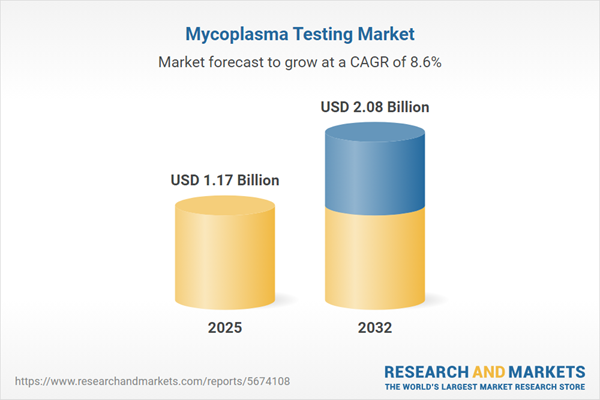Speak directly to the analyst to clarify any post sales queries you may have.
The Mycoplasma Testing Market is rapidly evolving as organizations across diagnostics, biopharma, and research intensify their focus on quality assurance and regulatory compliance. Advanced detection technologies combined with heightened regulatory standards are redefining operational best practices and competitive strategies.
Market Snapshot: Mycoplasma Testing Market Size and Growth Trajectory
The mycoplasma testing market grew from USD 1.08 billion in 2024 to USD 1.17 billion in 2025. It is expected to continue growing at a CAGR of 8.55%, reaching USD 2.08 billion by 2032. This upward trajectory highlights expanding demand for reliable, rapid, and compliant mycoplasma detection solutions across clinical diagnostics, biopharmaceutical development, and life science research settings. Increased global investments in biotechnology and rising regulatory demands are key contributors, positioning this market for sustained expansion.
Scope & Segmentation of the Mycoplasma Testing Market
This comprehensive report examines the core drivers and structural dynamics shaping the mycoplasma testing ecosystem. The market is segmented as follows:
- Test Type: Culture methods, PCR assays, serological assays
- Sample Type: Blood, throat swab, urine
- End User: Diagnostic laboratories, hospitals, pharmaceutical companies, research institutes
- Product: Kits, reagents, consulting services, installation and maintenance services
- Application: Clinical diagnostics (confirmatory testing, routine screening), pharmaceutical research (drug screening, vaccine research), broader R&D (drug development, epidemiology)
- Pathogen Type: Mycoplasma genitalium, Mycoplasma pneumoniae
- Region: Americas (including North America and Latin America), Europe, Middle East & Africa, Asia-Pacific
- Leading Companies: Thermo Fisher Scientific Inc., Merck KGaA, Lonza Group AG, Charles River Laboratories International Inc., Bio-Rad Laboratories Inc., Danaher Corporation, Roche Holding AG, Sartorius AG, Promega Corporation, QIAGEN N.V.
Within each segment, the report details current trends, relevant technologies, and operational considerations, emphasizing the interplay of global supply chains, local regulatory environments, and technological innovation.
Key Takeaways for Decision-Makers
- Detection technologies are shifting from traditional culture methods toward faster, high-sensitivity molecular and serological platforms, enabling more efficient risk mitigation for biological materials.
- Regulatory bodies are harmonizing and strengthening guidelines, which accelerates the adoption of standardized and automated workflows throughout the value chain.
- Integrated solutions that combine assay kits, digital analytics, and support services are becoming standard as collaborative partnerships proliferate in the industry.
- Manufacturers with early investments in regional production and those leveraging strategic alliances demonstrate greater resilience against supply disruptions and pricing volatility.
- Segment-specific needs—driven by test type, sample source, and pathogen—inform strategic purchasing and investment decisions in diagnostics, biopharma, and research organizations.
- Regional nuances require tailored approaches. For example, North America and Asia-Pacific emphasize technological leadership and local investment, while EMEA balances established procedures with new growth opportunities.
Tariff Impact on Supply Chains and Competitiveness
United States tariff measures through 2025 have increased operational complexity, incentivizing organizations to localize manufacturing or diversify sourcing strategies. Suppliers adapting to these shifts are better positioned to offer consistent availability and manage cost structures, while end users are re-evaluating vendor relationships and seeking more robust supply chain planning to navigate trade uncertainties.
Methodology & Data Sources
This report combines primary interviews with executives, laboratory leaders, and subject matter experts, with extensive secondary research encompassing regulatory documents, peer-reviewed literature, and conference proceedings. Analytical frameworks assess technology adoption, supply chain risk, and scenario planning for tariff impacts. Data validation is supported by industry advisors to ensure findings address current and future market imperatives.
Why This Report Matters for Strategic Leaders
- Gain clarity on technology trends, regulatory changes, and partnership strategies for robust mycoplasma testing operations.
- Benchmark competitive positioning by understanding regional market drivers and key company initiatives.
- Access actionable recommendations to strengthen supply chain resilience, accelerate product launches, and improve compliance outcomes across the mycoplasma testing landscape.
Conclusion
This report equips senior leaders with the knowledge to anticipate market developments, optimize technology investments, and build more resilient operations. Leveraging these insights supports informed decision-making in an increasingly complex and regulated mycoplasma testing environment.
Additional Product Information:
- Purchase of this report includes 1 year online access with quarterly updates.
- This report can be updated on request. Please contact our Customer Experience team using the Ask a Question widget on our website.
Table of Contents
3. Executive Summary
4. Market Overview
7. Cumulative Impact of Artificial Intelligence 2025
Companies Mentioned
The companies profiled in this Mycoplasma Testing market report include:- Thermo Fisher Scientific Inc.
- Merck KGaA
- Lonza Group AG
- Charles River Laboratories International Inc.
- Bio-Rad Laboratories Inc.
- Danaher Corporation
- Roche Holding AG
- Sartorius AG
- Promega Corporation
- QIAGEN N.V.
Table Information
| Report Attribute | Details |
|---|---|
| No. of Pages | 194 |
| Published | October 2025 |
| Forecast Period | 2025 - 2032 |
| Estimated Market Value ( USD | $ 1.17 Billion |
| Forecasted Market Value ( USD | $ 2.08 Billion |
| Compound Annual Growth Rate | 8.5% |
| Regions Covered | Global |
| No. of Companies Mentioned | 11 |









